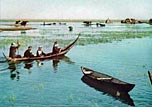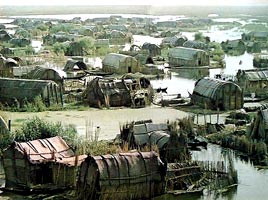 New Page 1
New Page 1
|
Tour in the South
Natural Sites and Outdoor Places
-
The great marshes of Mesopotamia (Chebayish): The unique world of
the marshes, where nature seems to preserve its virgin aspect. Miles and
miles of water, with an endless variety of birs and fish, of plants and
reeds and bulrushes, dotted as far as the eye can see with huts, each a
little island unto itself, with slender mash-hoofs shuttling back and
forth the reeds and flowers. This vast expanse of water is shared by
most southern governorates, Basrah, Misan, Thi qar, and Wasit. Old
Arabic books suggest that marshes were aftermath of devastating flood
which took place around A.D 620, but archaeological indications suggest
that they were formed long before Sumerian times, when the Arabian gulf
waters began to recede southwards, leaving behind all those marshes
alongside the Tigris and Euphrates. The best months for taking trips in
the marshes are during hunting season (October to March). The weather
becomes a hunter’s paradise. For further information on these marshes
please visit ( www.arabhunter.com). Fish, however, are always plentiful
and the local inhabitants catch them with nets or spear them with a
five-pronged “fala”, peculiar to the area. People in the marshes live in
huts built from reeds and reed-matting, with attractive designs that go
back to ancient times. They look like hundreds of islands clusterd
together into small town-ships. Most prominent among them is “Chebayish”,
on the left bank of the Euphrates. Each ‘island” is in fact a man-made
mixture of earth and papyrus pressed hard (to form a base of a hut) and
called “chebasheh”. The watery “streets” are piled by boats of
different kinds and sizes, the most popular being the mash-hoof, which
is made frame reeds and bitumen. A delightful scene is a marsh wedding,
when the bride is carried in a lovely “regatta” made up of her own mash-hoof
and those of her party, all loud with men’s lilting songs and women’s
joyous cries. A number of tourist cabins in Chibayish had been built in
recent years. To get to the marshes there are two ways: 1. by car from
Nasiriya to Chibayish ( a distance of about 100 kms), and thence by boat
to tour the place; 2. by car from Basrah to Qurna ( a distance of 74 kms)
, and thence by motor-boat to the marshes, or by car again for another
45 kms.

-
Adam’s tree – Qurna. As legend have it, is the place where the
Garden of Eden was. There is an old tree there still called Adam’s Tree.
74 kms to the north of Basrah, it rises at the confluence of the Tigris
and Euphrates into one very wide river, ‘SHAT AL ARAB”, amidst extensive
fields and palm groves.
-
Razaza Lake. On the way to Ukhaidher, some 18 kms, from Kerbala, is
Razzazeh lake, 60 x 30 kms. In recent years this beautiful large lake
has been drawing lovers of swimming, water sports and fishing in great
numbers. The Governorate of Kerbala has put up in the region many
tourist facilities, afforested and planted extensive area, and made
arrangements to have the place supplied with drinking water and
electricity.
-
Sawa Lake. Located near Samawa, in Al muthanna governorate, Lake
Sawa is famous for its natural beauty. A nearby rest house and
restaurant cater for visitors to the lake.
-
Shat al Arab: river trips on Shatt al arab are very easy to arrange
by simply hiring a motor-boat from the Corniche in Ashar. Here the
visitor will find endless number of “casinos” all along the river where
one can have a perfect view of the ships and liners sailing in and out,
of the tall palm trees that line the horizon, the buildings of the
University of Basrah glowing in the distance.
|


